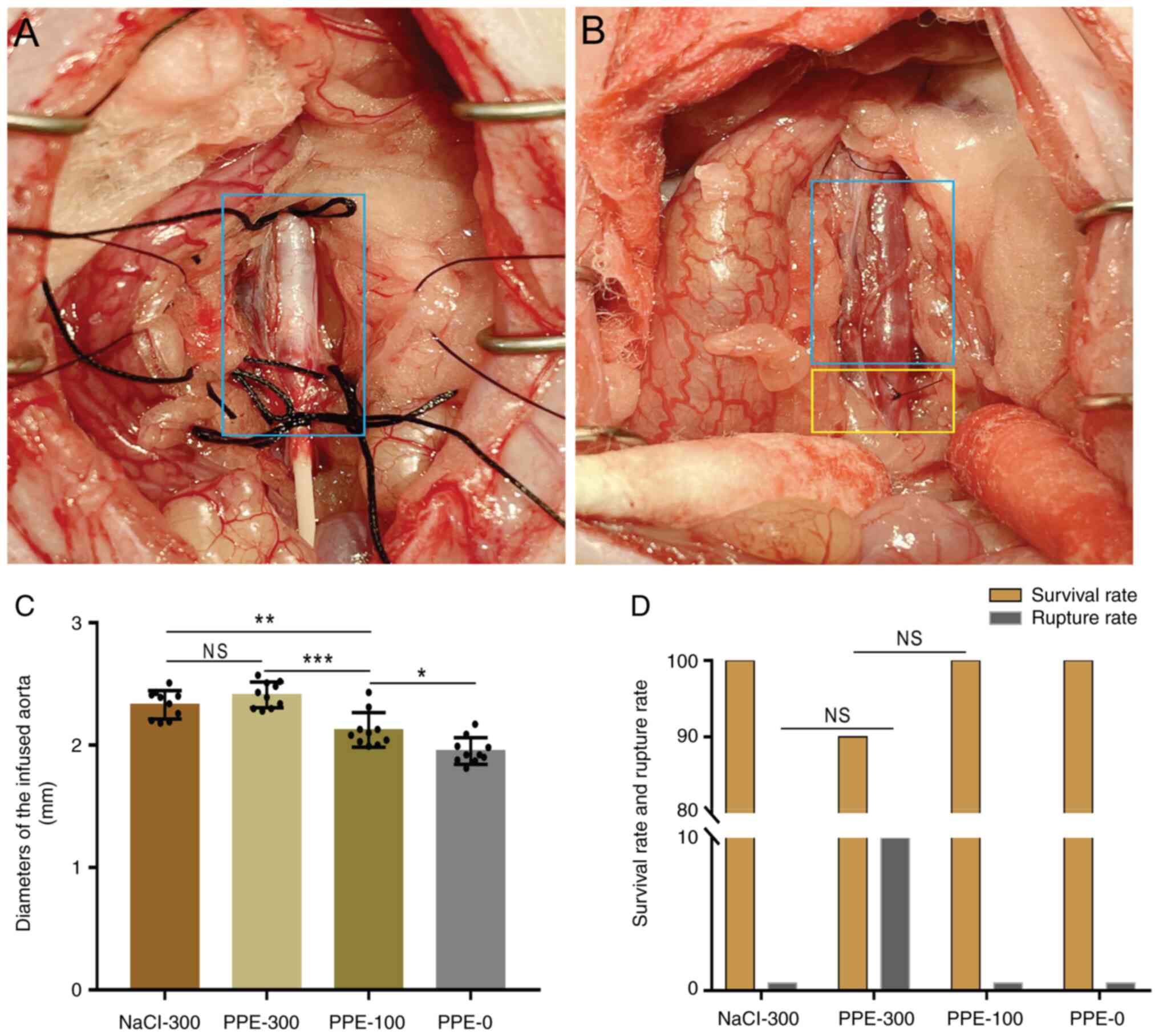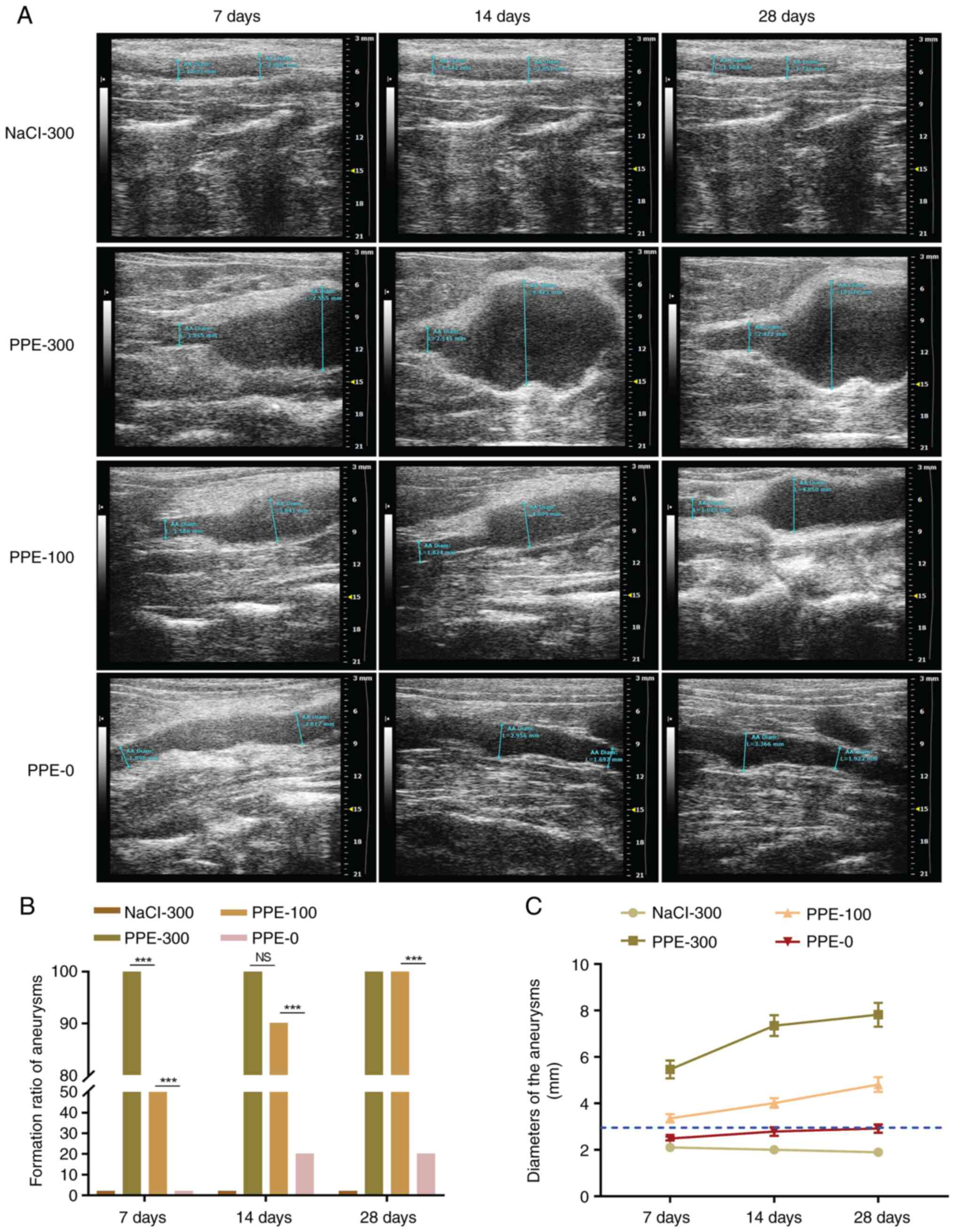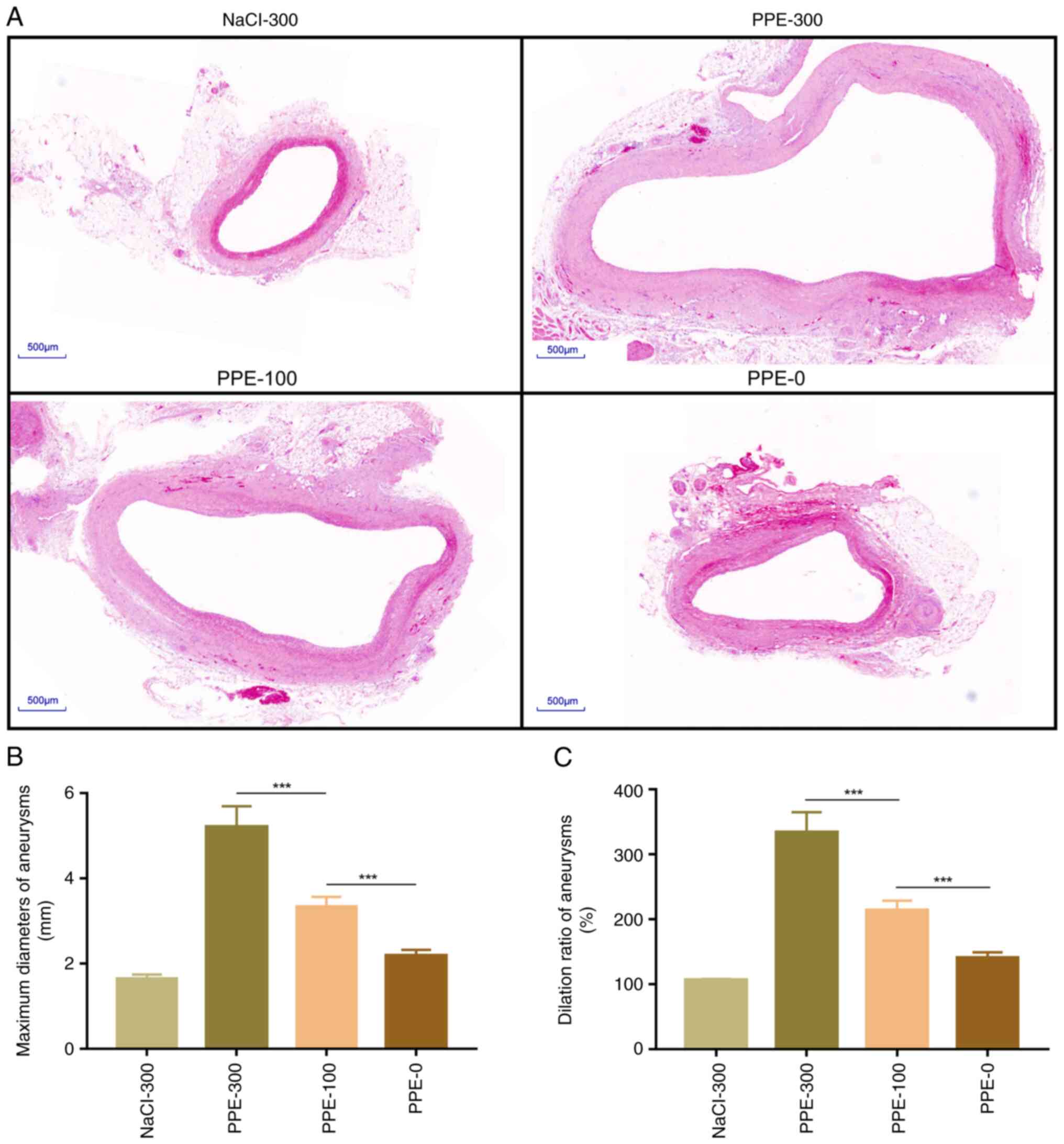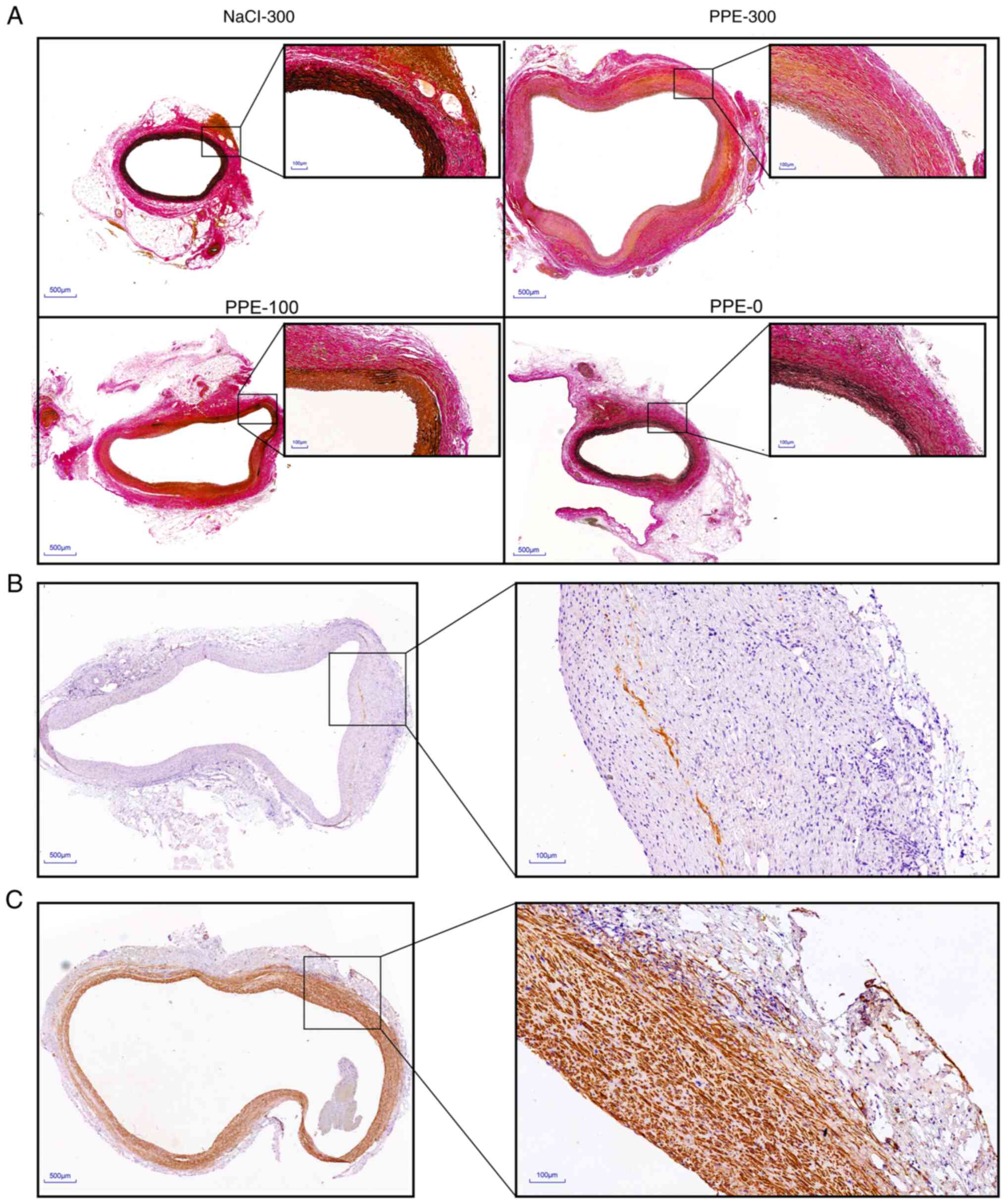|
1
|
Sakalihasan N, Limet R and Defawe OD:
Abdominal aortic aneurysm. Lancet. 365:1577–1589. 2005.PubMed/NCBI View Article : Google Scholar
|
|
2
|
Chaikof EL, Dalman RL, Eskandari MK,
Jackson BM, Lee WA, Mansour MA, Mastracci TM, Mell M, Murad MH,
Nguyen LL, et al: The society for vascular surgery practice
guidelines on the care of patients with an abdominal aortic
aneurysm. J Vasc Surg. 67:2–77.e2. 2018.PubMed/NCBI View Article : Google Scholar
|
|
3
|
Clancy K, Wong J and Spicher A: Abdominal
aortic aneurysm: A case report and literature review. Perm J.
23(18.218)2019.PubMed/NCBI View Article : Google Scholar
|
|
4
|
Schanzer A and Oderich GS: Management of
abdominal aortic aneurysms. N Engl J Med. 385:1690–1698.
2021.PubMed/NCBI View Article : Google Scholar
|
|
5
|
Tchana-Sato V, Sakalihasan N and Defraigne
JO: Ruptured abdominal aortic aneurysm. Rev Med Liege. 73:296–299.
2018.PubMed/NCBI(In French).
|
|
6
|
Wang YD, Liu ZJ, Ren J and Xiang MX:
Pharmacological therapy of abdominal aortic aneurysm: An update.
Curr Vasc Pharmacol. 16:114–124. 2018.PubMed/NCBI View Article : Google Scholar
|
|
7
|
Davis FM, Daugherty A and Lu HS: Updates
of recent aortic aneurysm research. Arterioscler Thromb Vasc Biol.
39:e83–e90. 2019.PubMed/NCBI View Article : Google Scholar
|
|
8
|
Patelis N, Moris D, Schizas D, Damaskos C,
Perrea D, Bakoyiannis C, Liakakos T and Georgopoulos S: Animal
models in the research of abdominal aortic aneurysms development.
Physiol Res. 66:899–915. 2017.PubMed/NCBI View Article : Google Scholar
|
|
9
|
Anidjar S, Salzmann JL, Gentric D, Lagneau
P, Camilleri JP and Michel JB: Elastase-induced experimental
aneurysms in rats. Circulation. 82:973–981. 1990.PubMed/NCBI View Article : Google Scholar
|
|
10
|
Xue C, Zhao G, Zhao Y, Chen YE and Zhang
J: Mouse abdominal aortic aneurysm model induced by perivascular
application of elastase. J Vis Exp: 10.3791/63608, 2022.
|
|
11
|
Wang Y, Krishna S and Golledge J: The
calcium chloride-induced rodent model of abdominal aortic aneurysm.
Atherosclerosis. 226:29–39. 2013.PubMed/NCBI View Article : Google Scholar
|
|
12
|
Quintana RA and Taylor WR: Cellular
mechanisms of aortic aneurysm formation. Circ Res. 124:607–618.
2019.PubMed/NCBI View Article : Google Scholar
|
|
13
|
Sénémaud J, Caligiuri G, Etienne H,
Delbosc S, Michel JB and Coscas R: Translational relevance and
recent advances of animal models of abdominal aortic aneurysm.
Arterioscler Thromb Vasc Biol. 37:401–410. 2017.PubMed/NCBI View Article : Google Scholar
|
|
14
|
Yamaguchi T, Yokokawa M, Suzuki M,
Higashide S, Katoh Y, Sugiyama S and Misaki T: Factors influencing
mortality in the rat elastase-induced-aneurysm model. J Surg Res.
94:81–83. 2000.PubMed/NCBI View Article : Google Scholar
|
|
15
|
Nie M, Yan Y, Li X, Feng T, Zhao X, Zhang
M and Zhao Q: Effect of low-pressurized perfusion with different
concentration of elastase on the aneurysm formation rate in the
abdominal aortic aneurysm model in rabbits. Biomed Res Int.
2016(6875731)2016.PubMed/NCBI View Article : Google Scholar
|
|
16
|
Busch A, Chernogubova E, Jin H, Meurer F,
Eckstein HH, Kim M and Maegdefessel L: Four surgical modifications
to the classic elastase perfusion aneurysm model enable
haemodynamic alterations and extended elastase perfusion. Eur J
Vasc Endovasc Surg. 56:102–109. 2018.PubMed/NCBI View Article : Google Scholar
|
|
17
|
Yamaguchi T, Yokokawa M, Suzuki M,
Higashide S, Katoh Y, Sugiyama S and Misaki T: Shortened elastase
infusion time in the elastase-induced rat aneurysm model. J Surg
Res. 85:158–162. 1999.PubMed/NCBI View Article : Google Scholar
|
|
18
|
Liu Z, Wang Q, Ren J, Assa CR, Morgan S,
Giles J, Han Q and Liu B: Murine abdominal aortic aneurysm model by
orthotopic allograft transplantation of elastase-treated abdominal
aorta. J Vasc Surg. 62:1607–1614.e2. 2015.PubMed/NCBI View Article : Google Scholar
|
|
19
|
Hu G, Dong Z and Fu W: A novel
modification of the murine elastase infusion model of abdominal
aortic aneurysm formation. Ann Vasc Surg. 42:246–253.
2017.PubMed/NCBI View Article : Google Scholar
|
|
20
|
Knipp BS, Ailawadi G, Sullivan VV, Roelofs
KJ, Henke PK, Stanley JC and Upchurch GR Jr: Ultrasound measurement
of aortic diameters in rodent models of aneurysm disease. J Surg
Res. 112:97–101. 2003.PubMed/NCBI View Article : Google Scholar
|
|
21
|
Suh MK, Batra R, Carson JS, Xiong W, Dale
MA, Meisinger T, Killen C, Mitchell J and Baxter BT: Ex vivo
expansion of regulatory T cells from abdominal aortic aneurysm
patients inhibits aneurysm in humanized murine model. J Vasc Surg.
72:1087–1096.e1. 2020.PubMed/NCBI View Article : Google Scholar
|
|
22
|
Liu B, Granville DJ, Golledge J and
Kassiri Z: Pathogenic mechanisms and the potential of drug
therapies for aortic aneurysm. Am J Physiol Heart Circ Physiol.
318:H652–H670. 2020.PubMed/NCBI View Article : Google Scholar
|
|
23
|
Azuma J, Asagami T, Dalman R and Tsao PS:
Creation of murine experimental abdominal aortic aneurysms with
elastase. J Vis Exp. (1280)2009.PubMed/NCBI View
Article : Google Scholar
|
|
24
|
Daugherty A and Cassis LA: Mouse models of
abdominal aortic aneurysms. Arterioscler Thromb Vasc Biol.
24:429–434. 2004.PubMed/NCBI View Article : Google Scholar
|
|
25
|
Munezane T, Hasegawa T, Suritala Tanaka A,
Okada K and Okita Y: Activation of transglutaminase type 2 for
aortic wall protection in a rat abdominal aortic aneurysm
formation. J Vasc Surg. 52:967–974. 2010.PubMed/NCBI View Article : Google Scholar
|
|
26
|
Liu R, Huang J, Ge Y, Liu S, Huang T, Cai
H, Pan B, Zhang Q, Yang P, Liao M, et al: Inhibition of
phosphatidylinositol 3-kinase γ by IPI-549 attenuates abdominal
aortic aneurysm formation in mice. Eur J Vasc Endovasc Surg.
60:254–263. 2020.PubMed/NCBI View Article : Google Scholar
|
|
27
|
Yu J, Liu R, Huang J, Wang L and Wang W:
Inhibition of phosphatidylinositol 3-kinease suppresses formation
and progression of experimental abdominal aortic aneurysms. Sci
Rep. 7(15208)2017.PubMed/NCBI View Article : Google Scholar
|
|
28
|
Wen H, Wang M, Gong S, Li X, Meng J, Wen
J, Wang Y, Zhang S and Xin S: Human umbilical cord mesenchymal stem
cells attenuate abdominal aortic aneurysm progression in
sprague-dawley rats: Implication of vascular smooth muscle cell
phenotypic modulation. Stem Cells Dev. 29:981–993. 2020.PubMed/NCBI View Article : Google Scholar
|
|
29
|
Wang Y, Jia L, Xie Y, Cai Z, Liu Z, Shen
J, Lu Y, Wang Y, Su S, Ma Y and Xiang M: Involvement of
macrophage-derived exosomes in abdominal aortic aneurysms
development. Atherosclerosis. 289:64–72. 2019.PubMed/NCBI View Article : Google Scholar
|
|
30
|
Fan Y, Li N, Liu C, Dong H and Hu X:
Excessive methionine supplementation exacerbates the development of
abdominal aortic aneurysm in rats. J Vasc Res. 56:230–240.
2019.PubMed/NCBI View Article : Google Scholar
|
|
31
|
Lu H, Du W, Ren L, Hamblin MH, Becker RC,
Chen YE and Fan Y: Vascular smooth muscle cells in aortic aneurysm:
From genetics to mechanisms. J Am Heart Assoc.
10(e023601)2021.PubMed/NCBI View Article : Google Scholar
|
|
32
|
Sinha I, Sinha-Hikim AP, Hannawa KK, Henke
PK, Eagleton MJ, Stanley JC and Upchurch GR Jr:
Mitochondrial-dependent apoptosis in experimental rodent abdominal
aortic aneurysms. Surgery. 138:806–811. 2005.PubMed/NCBI View Article : Google Scholar
|
|
33
|
Hoshina K, Koyama H, Miyata T, Shigematsu
H, Takato T, Dalman RL and Nagawa H: Aortic wall cell proliferation
via basic fibroblast growth factor gene transfer limits progression
of experimental abdominal aortic aneurysm. J Vasc Surg. 40:512–518.
2004.PubMed/NCBI View Article : Google Scholar
|
|
34
|
Lewis DA, Ding YH, Dai D, Kadirvel R,
Danielson MA, Cloft HJ and Kallmes DF: Morbidity and mortality
associated with creation of elastase-induced saccular aneurysms in
a rabbit model. AJNR Am J Neuroradiol. 30:91–94. 2009.PubMed/NCBI View Article : Google Scholar
|


















